Evaluation of Agricultural Water Resources Allocation Efficiency and Its Influencing Factors in the Yellow River Basin
Abstract
:1. Introduction
2. Materials and Methods
2.1. Study Area
2.2. Data Description
2.3. Research Methods
2.3.1. Super-Efficiency SBM Model
2.3.2. Malmquist Index Model
2.3.3. Standard Deviation Ellipse Analysis
2.3.4. Spatial Autocorrelation Analysis
2.3.5. Tobit Regression Model
3. Results
3.1. Spatiotemporal Characteristics of the AWRAE in the Yellow River Basin
3.2. Gravity Shift and Dispersion Trend of the AWRAE
3.3. Spatial Autocorrelation Analysis of the AWRAE
3.4. Dynamic Malmquist Index of the AWRAE and Its Decomposition
3.5. Driving Factors of the AWRAE
4. Discussion
5. Conclusions
- (1)
- The AWRAE is at the medium level with the value being 0.768 in the Yellow River Basin, and the AWRAE ranking from large to small is as follows: Sichuan > Shaanxi > Ningxia > Henan > Inner Mongolia > Shanxi > Qinghai > Shandong > Gansu. The changes of the AWRAE are relatively large, with 36.38%, 31.90%, 38.95%, 37.81% and 37.53%, respectively, in Qinghai, Gansu, Shanxi, Henan and Shandong, and the AWRAE shows a significant increasing trend in Inner Mongolia, Shanxi, Henan and Shandong.
- (2)
- The gravity center of the AWRAE keeps wandering along the provincial boundaries of Gansu and Shaanxi, which shows a counterclockwise rotation trend. The AWRAE expands in the east–west direction with its aggregation decreasing, while it contracts in the north–south direction with its aggregation increasing in the Yellow River Basin. The AWRAE of Shaanxi shows significant H-H aggregation in 2000, 2005, 2010 and 2015 (p < 0.05), significant L-H aggregation in 2000 (Shandong, p < 0.001) and 2005 (Gansu, p < 0.01), and significant H-L aggregation in 2015 (Sichuan, p < 0.05).
- (3)
- The AWRAE has been continuously improved in the Yellow River Basin with the Techch and Effch promoting the improvement while the Pech restricting the improvement. The AWRAE is mainly restricted by the Effch in Qinghai, Sichuan, Gansu, Ningxia and Shandong. In addition, the Pech are all less than 1 in Sichuan, Ningxia and Shandong, which are restricted by the pure technical efficiency. The Tfpch and Techch have a large change range during 2000–2020 and the trends are basically the same, while the Effch, Pech and Sech showed relatively small changes.
- (4)
- The influencing factors of the AWRAE in different provinces and autonomous regions are significantly different; for example, in Qinghai Province, the AMTP has a significant positive effect on the AWRAE, while the AAP, AW, WIA and WIM have significant negative effects. For Shandong, the AAP, CFCEC, CPC and PERA all have significant negative impacts on the AWRAE.
- (5)
- Due to the multiple impacts of the policies, economic development level, agricultural development level, total water resources and population pressure in the provinces and autonomous regions, the AWRAE is characterized by temporal and spatial differences in the Yellow River Basin; therefore, it is necessary to clearly understand the internal and external factors that affect the total factor productivity of the AWRAE and then take targeted measures to improve the AWRAE in the Yellow River Basin.
Author Contributions
Funding
Data Availability Statement
Conflicts of Interest
References
- Hao, M.; Duan, L.Q.; Chen, C.Y.; Liang, L.T.; Pan, T. Differences in agricultural water use efficiency and its influencing factors between Yellow River Basin and Yangtze River Economic Belt. J. Soil Water Conserv. 2022, 4, 267–277. (In Chinese) [Google Scholar]
- Yin, X.; Liu, X.G.; Zhang, Y.; Geng, H.Z.; Yang, Q.L.; Yang, J.R. Efficiency evaluation of agricultural water resources in Yunnan province based on Projection Pursuit model. Bull. Soil Water Conserv. 2013, 5, 271–275. (In Chinese) [Google Scholar]
- Liu, X.Z.; Li, W.C.; Zhao, Z.Y.; Wang, X.; Wang, S.; Dong, Y.P. Evaluation of agricultural water resources utilization efficiency in Ningxia based on Projection Pursuit. Water Sav. Irrig. 2017, 11, 46–51. (In Chinese) [Google Scholar]
- Wang, J.P.; Liu, G.Y.; Zhu, M.L. Measurement and influential factors of irrigation water use efficiency in Xinjiang. Water Sav. Irrig. 2016, 1, 63–67. (In Chinese) [Google Scholar]
- Chen, S.Y.; Cheng, H.M.; Yu, G.J.; Tian, W. Study on technical efficiency and coupling relationship of Guangxi agricultural water resources utilization based on Panel Data Stochastic Frontier Model. Acta Agric. Jiangxi 2019, 7, 117–123. (In Chinese) [Google Scholar]
- Cui, Y.; Wu, L.M.; Qu, J.H.; Ma, Y.M. Measurement of the efficiency of agricultural water resources production and allocation of Henan Province. J. Henan Agric. Univ. 2014, 4, 501–504. (In Chinese) [Google Scholar]
- Li, M.D. Regionalization of agricultural water use efficiency based on DEA method. Chin. J. Agric. Resour. Reg. Plan. 2017, 9, 106–114. (In Chinese) [Google Scholar]
- Li, S.Y.; Liu, X.B. Study on utilization efficiency of agricultural water resources in the Beijing-Tianjin-Hebei Region based on DEA model. Tianjin Agric. Sci. 2021, 9, 69–74. (In Chinese) [Google Scholar]
- Du, S.; Liang, Y.Q.; Zhang, M.; An, X.Y.; Wang, H. A study on spatio-temporal differentiation characteristic and influencing factors of agricultural water resource utilization efficiency in Hebei Province. Water Sav. Irrig. 2021, 6, 74–80. (In Chinese) [Google Scholar]
- Lu, Q.Z.; Lu, G.J.; Fan, Z.L.; Mo, L.Y. A study on utilization efficiency of agricultural water resources and its influential factors in Guangxi based on Global Super-Efficiency DEA and Tobit Model. Water Sav. Irrig. 2018, 8, 54–58. (In Chinese) [Google Scholar]
- Liu, Y.; Du, J. An empirical analysis of agricultural water utilization efficiency in Hubei Province. China Rural Water Hydropower 2011, 1, 37–39. (In Chinese) [Google Scholar]
- Miao, X.F.; Li, A.; Yu, Y.M.; Su, M. Evaluation and spatiotemporal evolution of agricultural water use efficiency in the Yangtze River Economic Belt—Based on SBM-Malmquist model. Hubei Agric. Sci. 2023, 4, 69–76. (In Chinese) [Google Scholar]
- Lu, W.N.; Guo, X.Y.; Liu, W.X.; Du, R.R.; Chi, S.Y.; Zhou, B.Y. Spatial-temporal dynamic evolution and influencing factors of green efficiency of agricultural water use in the Yellow River Basin, China. Water 2022, 1, 143. [Google Scholar] [CrossRef]
- Zhang, S.J.; Liu, J.; Li, C.Z.; Yu, F.L.; Jing, L.S.; Chen, W.F. Evaluation of water resources utilization efficiency based on DEA and AHP under climate change. Water 2023, 4, 718. [Google Scholar] [CrossRef]
- Zhao, L.P.; Li, D.J.; Hou, D.L.; Li, J.L. Tempo-spatial variations of agricultural water use efficiency measurements in Hubei Province from 2003 to 2016. J. Water Resour. Water Eng. 2020, 5, 240–247. (In Chinese) [Google Scholar]
- Zhao, Y.T.; Wang, Y.Y. An empirical analysis of agricultural water resources utilization efficiency in Gansu Province along the Yellow River based on DEA-Malmquist index method. J. Lanzhou Jiaotong Univ. 2022, 1, 105–111. (In Chinese) [Google Scholar]
- Wang, W.; Elahi, E.; Sun, S.Y.; Tong, X.Q.; Zhang, Z.S.; Abro, M.I. Factors influencing water use efficiency in agriculture: A Case Study of Shaanxi, China. Sustainability 2023, 3, 2157. [Google Scholar] [CrossRef]
- Zhang, H.T.; Zhou, Y.X.; Wang, X.J. Research on agricultural water use efficiency in Shandong Province based on DEA-Malmquist Model. J. Shandong Agric. Univ. Soc. Sci. Ed. 2023, 1, 47–53. (In Chinese) [Google Scholar]
- Dong, H.G.; Geng, J.; Xu, Y. Receiving robust analysis of spatial and temporary variation of agricultural water use efficiency while considering environmental factors: On the evaluation of data Envelopment Analysis Technique. Sustainability 2023, 5, 3926. [Google Scholar] [CrossRef]
- Song, M.L.; Wang, R.; Zeng, X.Q. Water resources utilization efficiency and influence factors under environmental restrictions. J. Clean. Prod. 2018, 184, 611–621. [Google Scholar] [CrossRef]
- Cui, Y.Z.; Liu, T. Research on the measurement and influencing factors of agricultural water total factor productivity in the Yellow River Basin. China Rural Water Hydropower 2021, 6, 126–129+136. (In Chinese) [Google Scholar]
- Liu, Y.; Song, Y. Evaluation and influencing factor analysis of agricultural water resource efficiency in China based on Super-efficiency SBM Model. China Rural Water Hydropower 2019, 1, 102–107. (In Chinese) [Google Scholar]
- Wang, F.T.; Yu, C.; Xiong, L.C.; Chang, Y. How can agricultural water use efficiency be promoted in China? A spatial-temporal analysis. Resour. Conserv. Recycl. 2019, 145, 411–418. [Google Scholar] [CrossRef]
- Su, X.L. Advance of optimal allocation of water resources in agriculture: A Review. J. Irrig. Drain. 2022, 7, 1–7+34. (In Chinese) [Google Scholar]
- Peng, L.; Deng, W.; Tan, J.; Lin, L. Restriction of economic development in the Hengduan Mountains Area by land and water resources. Acta Geogr. Sin. 2020, 9, 1996–2008. (In Chinese) [Google Scholar]
- Jin, T. The adjustment of China’s grain cropping structure and its effect on the consumption of water and land resources. J. Nat. Resour. 2019, 1, 14–25. (In Chinese) [Google Scholar] [CrossRef]
- Zhang, Z.Y.; Tian, M.H.; Li, J.J.; Wang, F.; Ma, S. Analysis and research on the value of farmland transfer based on environmental protection evaluation system. IOP Conf. Ser. Earth Environ. Sci. 2021, 4, 042013. [Google Scholar] [CrossRef]
- Yang, H.Y.; Zhao, H.F. Analysis of spatio-temporal characteristics and effects of land and water resources matching under cultivated land structure change: A case study of Heilongjiang province. J. Nat. Resour. 2022, 9, 2247–2263. (In Chinese) [Google Scholar] [CrossRef]
- Kuang, Y.P.; Yang, P.Y. Analysis on allocation efficiency of land and water resources for grain and its influencing factors in China. Bull. Soil Water Conserv. 2023; accepted. (In Chinese). [Google Scholar] [CrossRef]
- Bai, F.F.; Qi, X.B.; Qiao, D.M.; Han, Y.; Zhao, Y.L.; Lu, H.F. Evaluation of Agricultural Water Resource Utilization Efficiency and Obstacle Factor Diagnoses in Provinces of the Yellow River Basin. J. Soil Water Conserv. 2022, 3, 146–152. (In Chinese) [Google Scholar]
- Tone, K.A. A slacks-based measure of efficiency in data envelopment analysis. Eur. J. Oper. Res. 2001, 3, 498–509. [Google Scholar] [CrossRef]
- Wang, Y.; Feng, J.H. Measurement and analysis of provincial green development efficiency in China-Based on the Super-efficiency SBM-Malmquist Model. J. Heilongjiang Vocat. Inst. Ecol. Eng. 2023, 3, 7–12. (In Chinese) [Google Scholar]
- Wang, C.H.; Gong, W.F.; Zhao, M.Z.; Zhou, Y.L.; Zhao, Y. Spatio-temporal evolution characteristics of eco-efficiency in the Yellow River Basin of China based on the super-efficient SBM model. Environ. Sci. Pollut. Res. 2023, 30, 72236–72247. [Google Scholar] [CrossRef] [PubMed]
- Zhang, W.J.; Xu, N.; Li, C.Y.; Cui, X.H.; Zhang, H.; Chen, W.X. Impact of digital input on enterprise green productivity: Micro evidence from the Chinese manufacturing industry. J. Clean. Prod. 2023, 414, 137272. [Google Scholar] [CrossRef]
- Xiao, Y.M.; Long, Q. Analysis on forestry eco-efficiency in Yunnan Province Based on DEA-SBM and Malmquist Model. J. Anhui Agric. Sci. 2023, 7, 142–145, 153. (In Chinese) [Google Scholar]
- Zhang, H.; Sun, Y.Q.; Fan, Z.Y.; Long, Z.; Wan, S.L.; Zhang, Z.L.; Chen, X.P. Analysis of county-scale eco-efficiency and spatiotemporal characteristics in China. Land 2023, 2, 438. [Google Scholar] [CrossRef]
- Ma, X.L. Study on temporal evolution and spatial reconstruction of crop virtual water in Jilin Province. Res. Soil Water Conserv. 2022, 2, 304–329. (In Chinese) [Google Scholar]
- Liu, W.; Li, H.X.; Xu, H.; Zhang, X.T.; Xie, Y.C. Spatiotemporal distribution and driving factors of regional green spaces during rapid urbanization in Nanjing metropolitan area, China. Ecol. Indic. 2023, 148, 110058. [Google Scholar] [CrossRef]
- Cheng, Y.; Wang, J.J.; Wang, Y.P.; Ren, J.L. A comparative research of the spatial-temporal evolution track and influence mechanism of green development in China. Geogr. Res. 2019, 11, 2745–2765. (In Chinese) [Google Scholar]
- Zhang, Y.; Wang, F.Y.; Du, Z.J.; Dou, M.; Liang, Z.J.; Gao, Y.; Li, P. Spatio-temporal distribution characteristics and driving factors of main grain crop water productivity in the Yellow River Basin. Plants 2023, 12, 580. [Google Scholar] [CrossRef]
- Liao, J.J.; Yu, C.Y.; Feng, Z.; Zhao, H.F.; Wu, K.N.; Ma, X.Y. Spatial differentiation characteristics and driving factors of agricultural eco-efficiency in Chinese Provinces from the perspective of ecosystem services. J. Clean. Prod. 2021, 288, 125466. [Google Scholar] [CrossRef]
- Zhang, Q. Analysis on the impact of industrial agglomeration on green development efficiency of cultural manufacturing industry based on Super-efficiency SBM-Malmquist-Tobit Model. J. Chuzhou Univ. 2023, 1, 39–51. (In Chinese) [Google Scholar]
- He, W.X.; Fu, J.H.; Luo, Y.X. A study of well-being-based eco-efficiency based on Super-SBM and Tobit Regression Model: The case of China. Soc. Indic. Res. 2023, 167, 289–317. [Google Scholar] [CrossRef]
- Zuo, Q.T.; Wang, P.K.; Zhang, Z.Z.; Wu, Q.S. Utilization level and improvement approach of water resources in the Yellow River Basin. J. Zhengzhou Univ. Eng. Sci. 2023, 3, 12–19. [Google Scholar]
- Yu, F.W.; Fang, L. Several issues on ecological protection and high-quality development of the Yellow River Basin. China Soft Sci. 2020, 6, 85–95. (In Chinese) [Google Scholar]
- Liu, C.M. Understanding of ecological protection and high quality development in the Yellow River Basin. Yellow River 2019, 10, 158. (In Chinese) [Google Scholar]
- Jin, F.J. Coordinated promotion strategy of ecological protection and high quality development in the Yellow River Basin. Reform 2019, 11, 33–39. (In Chinese) [Google Scholar]
- Kang, S.Z. National water conservation initiative for promoting water-adapted and green agriculture and highly-efficient water use. China Water Resour. 2019, 13, 1–6. (In Chinese) [Google Scholar]
- Qi, X.B.; Li, P.; Bai, F.F.; Zhang, Y.; She, Y.J.; Ma, C.C. Effect of climate change on water resource allocation to irrigation: A Review. J. Irrig. Drain. 2022, 8, 1–8. (In Chinese) [Google Scholar]
- Zhang, J.Y. Action of national water conservation highlights impact of climate change. China Water Resour. 2018, 6, 11–13. (In Chinese) [Google Scholar]
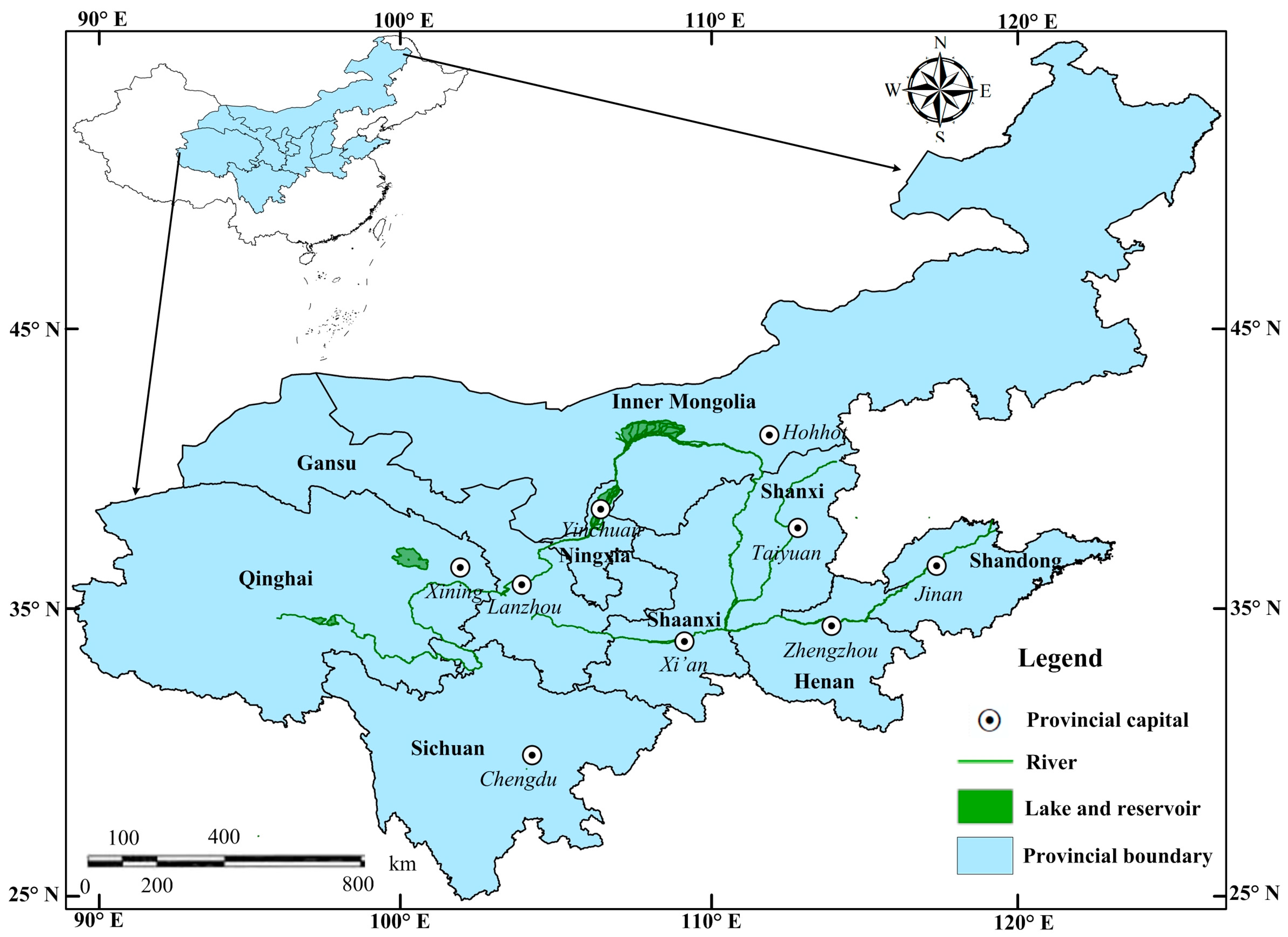
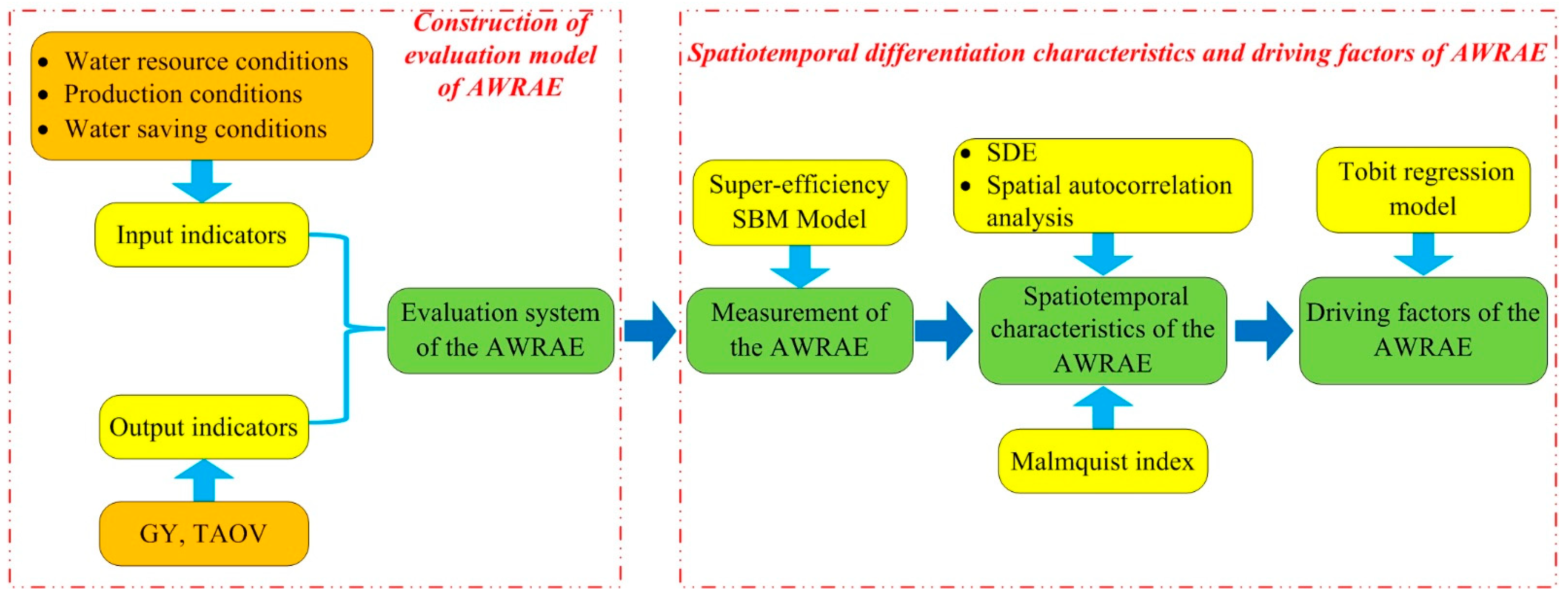
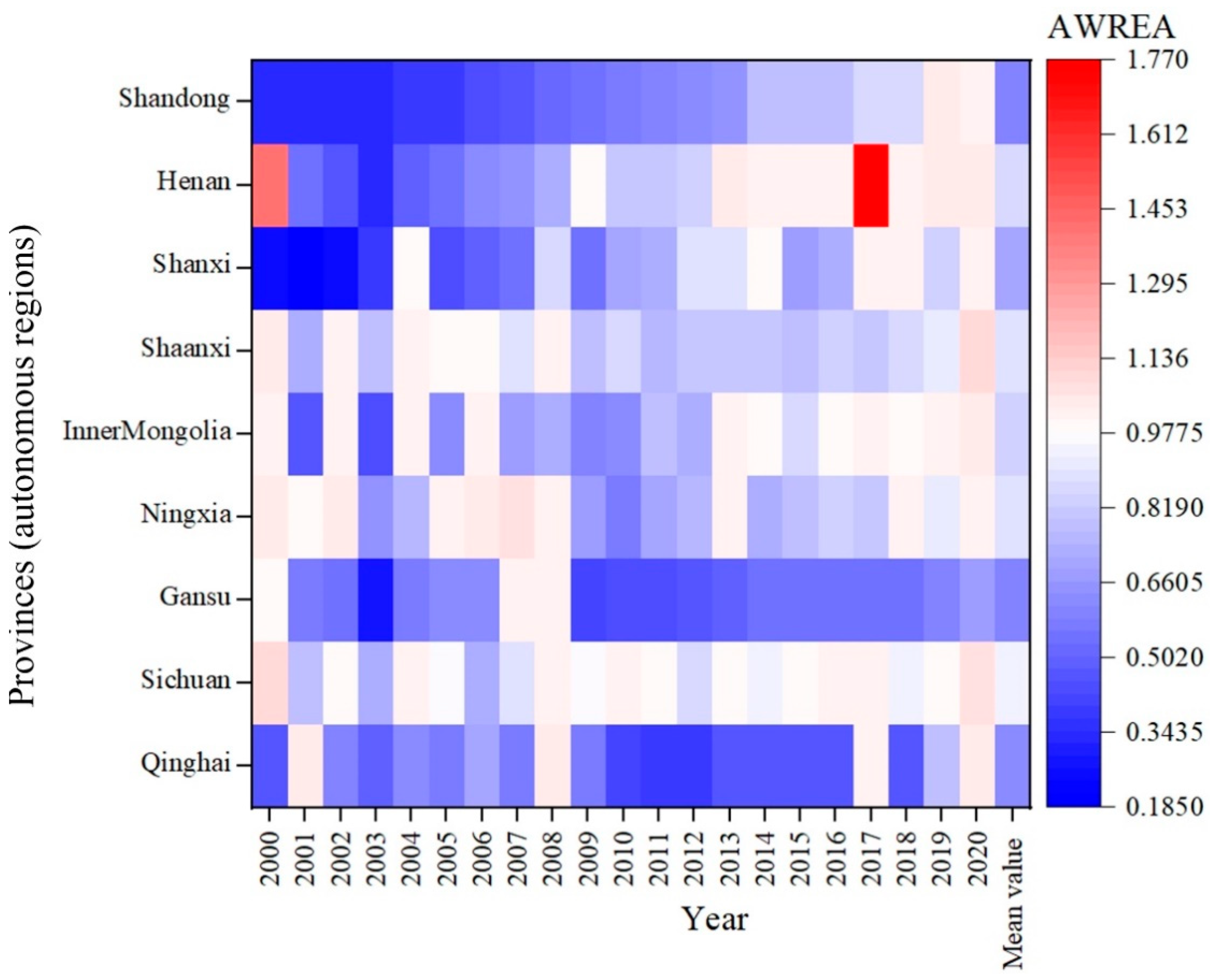

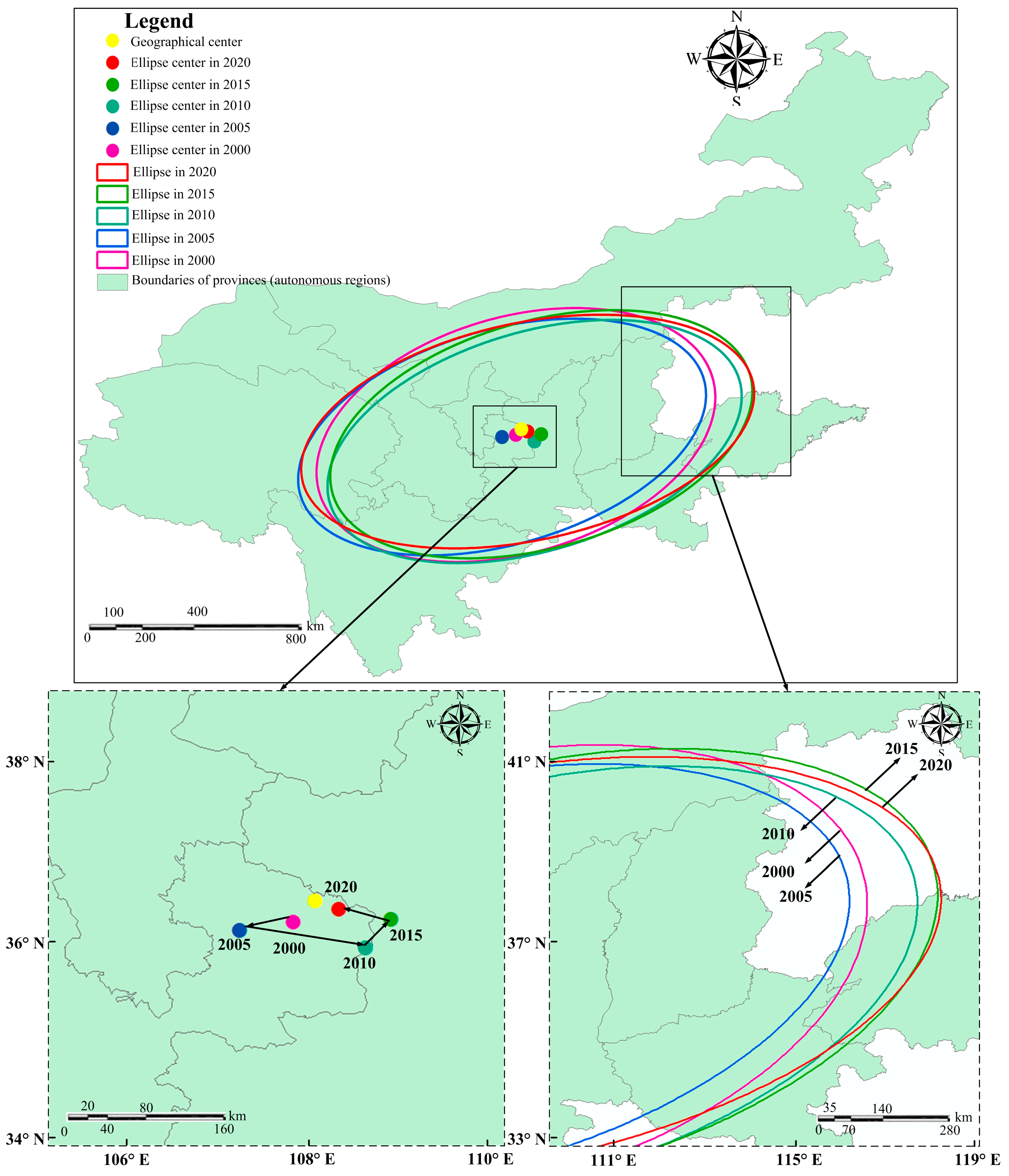
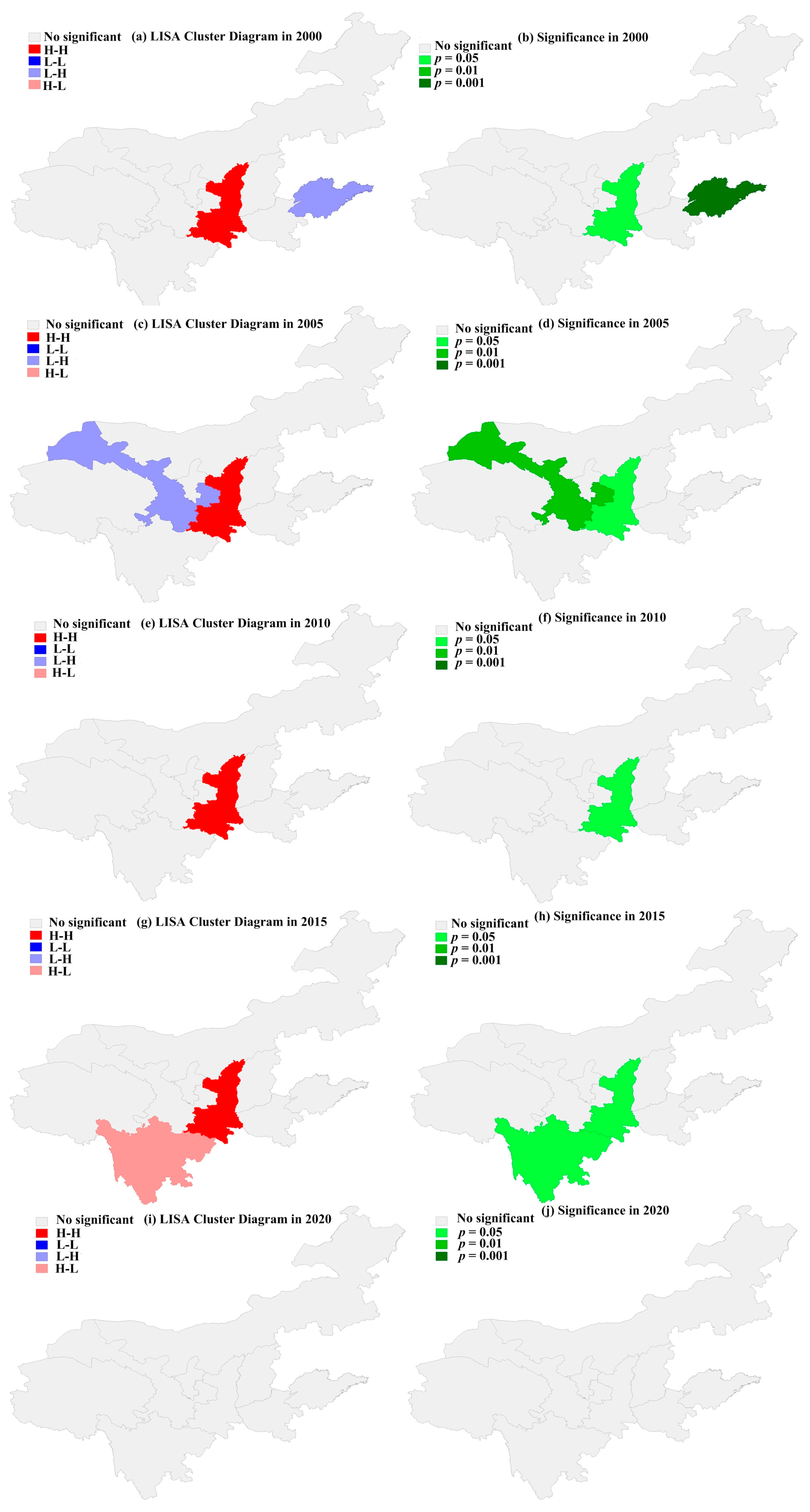
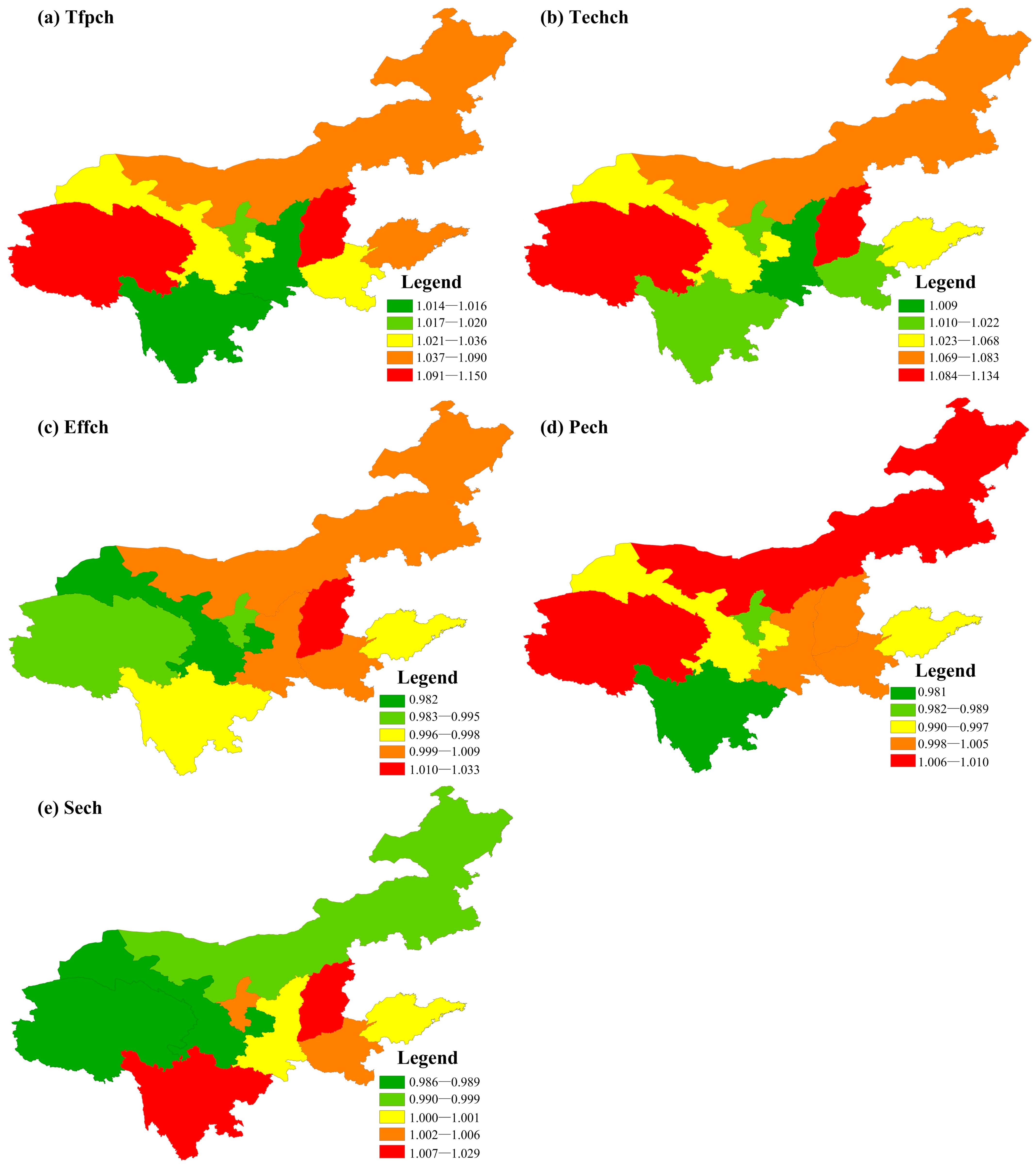

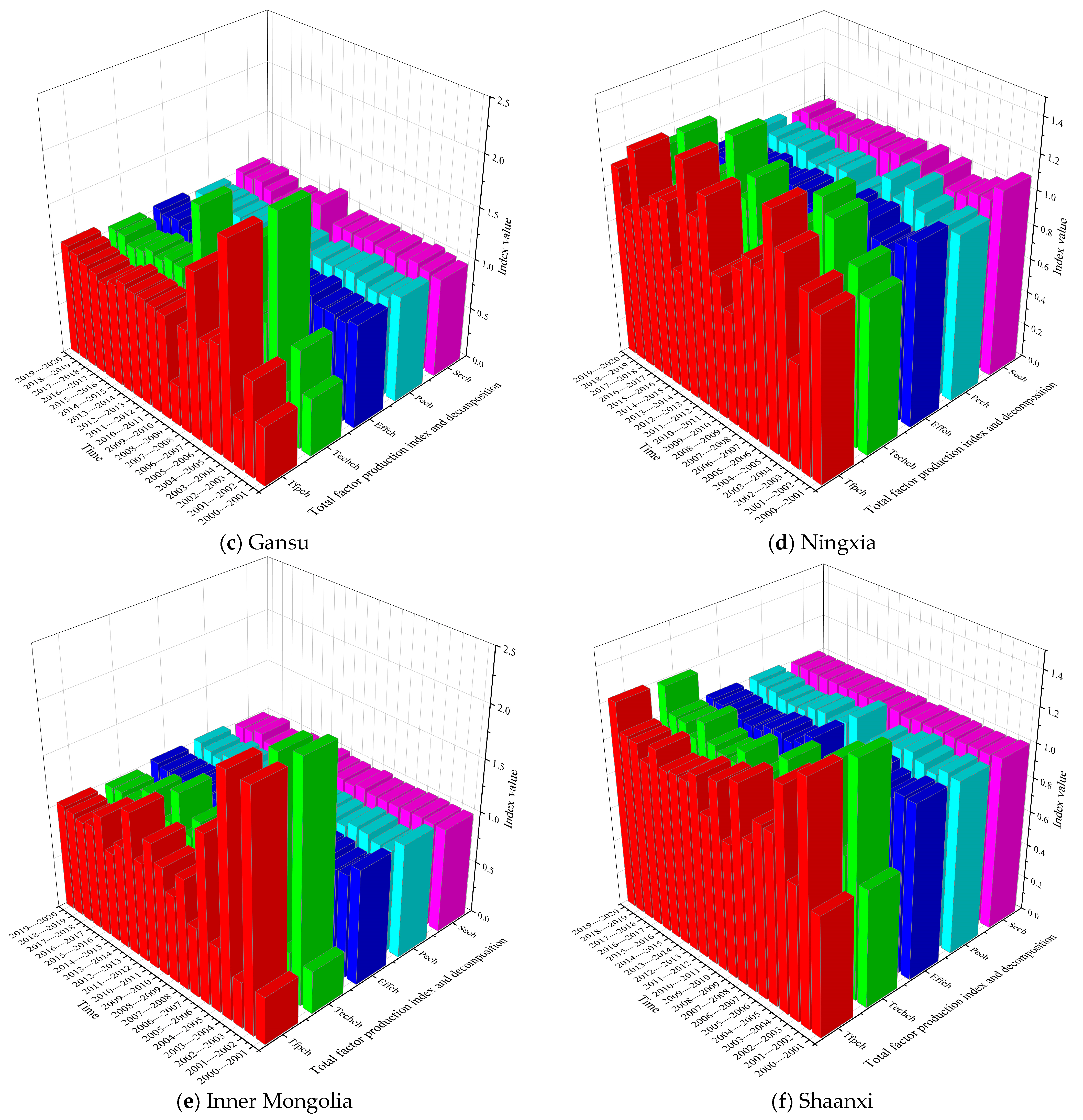
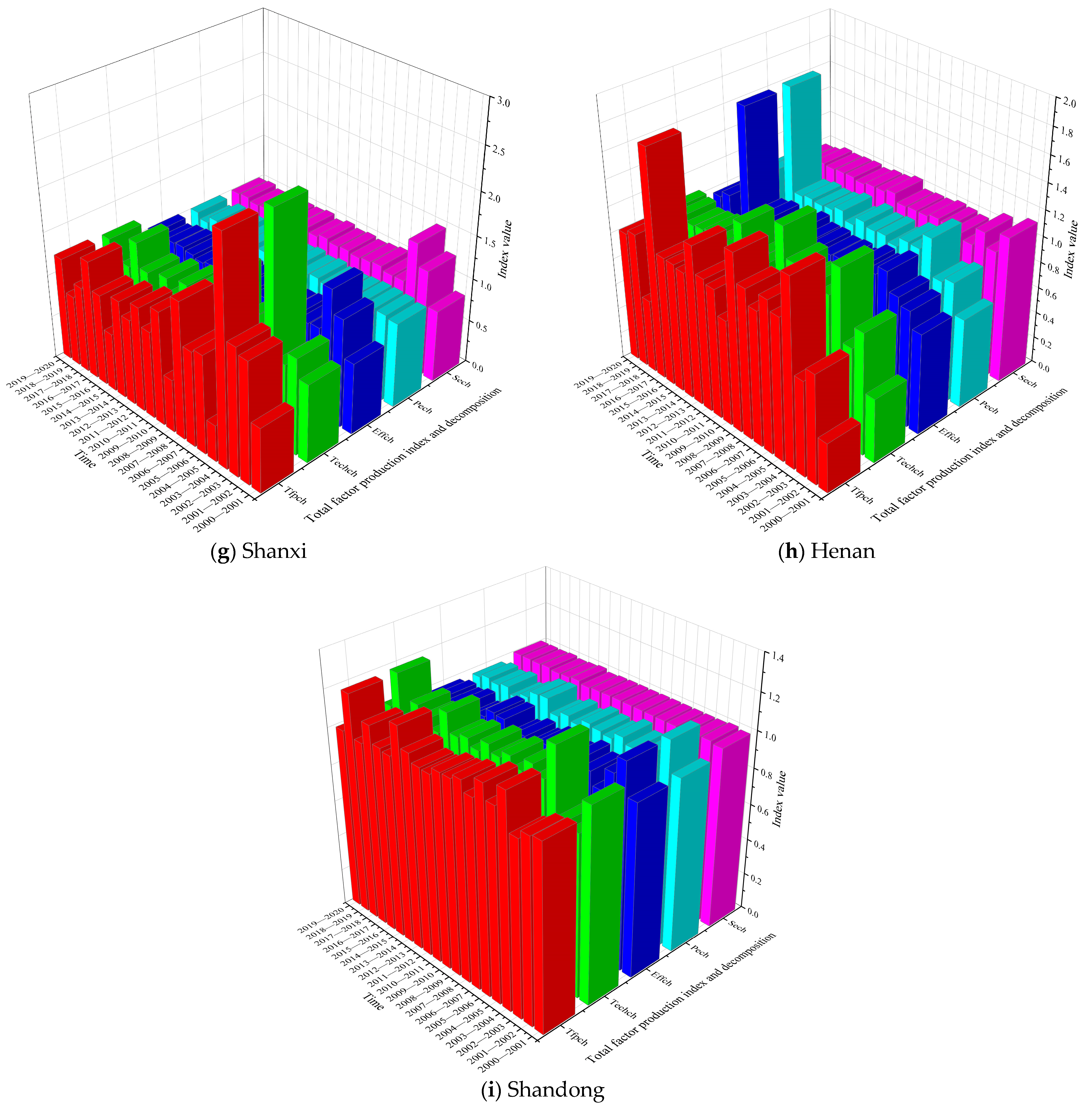

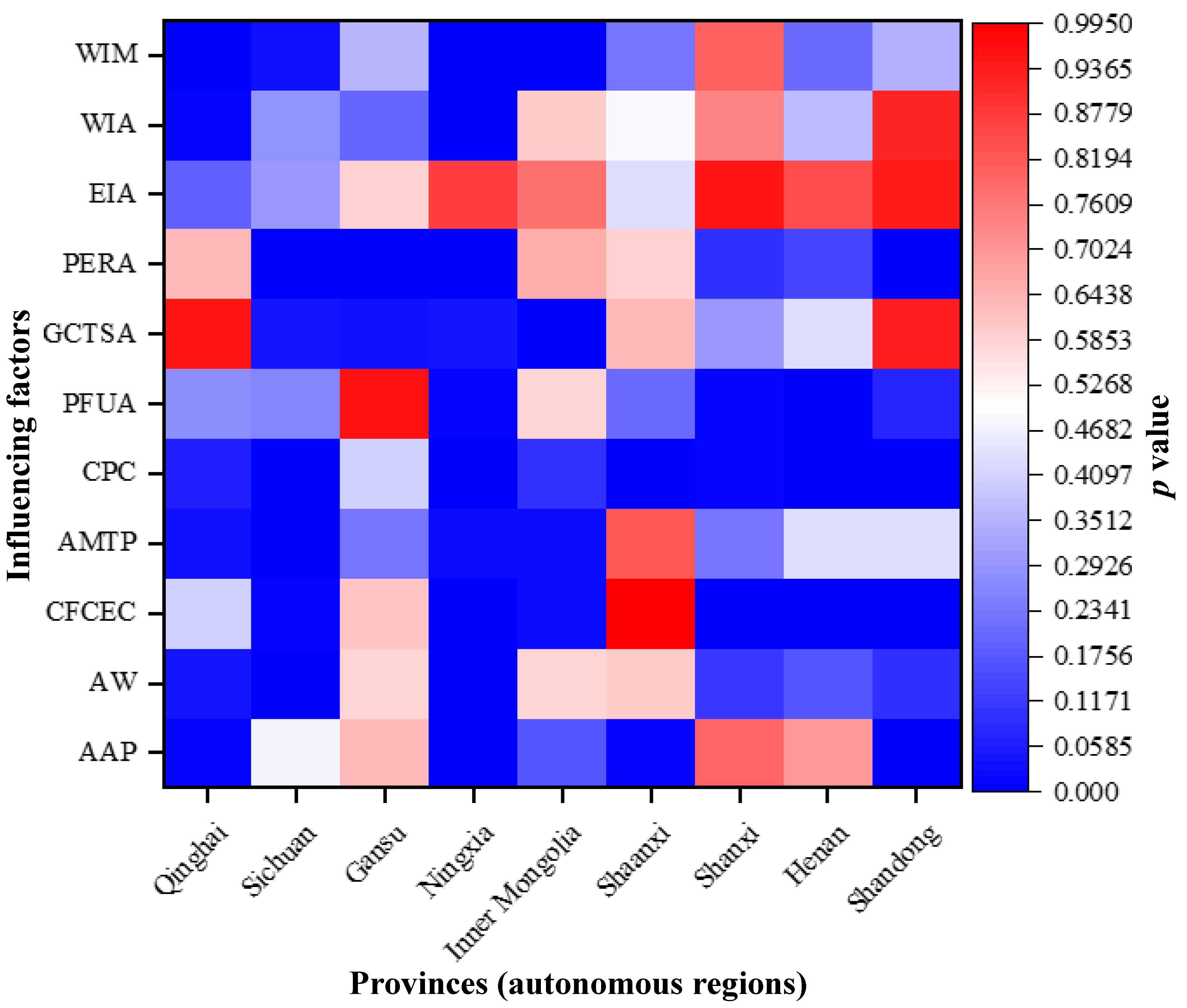
| Number | Indicator Classification | Name | Abbreviation | Unit | |
|---|---|---|---|---|---|
| 1 | Input indicator | Water resource conditions | annual average precipitation | AAP | mm |
| 2 | agricultural water | AW | 108 m3 | ||
| 3 | Production conditions | consumption of chemical fertilizer by 100% effective component | CFCEC | 10,000 tons | |
| 4 | total power of agricultural machinery | AMTP | 10,000 kw | ||
| 5 | consumption of chemical pesticides | CPC | ton | ||
| 6 | plastic film use for agricultural | PFUA | ton | ||
| 7 | total sown area of grain crops | GCTSA | 1000 hectares | ||
| 8 | persons engaged in rural area | PERA | 10,000 person | ||
| 9 | Water saving conditions | effective irrigated area | EIA | 1000 hectares | |
| 10 | water saving irrigated area | WIA | 1000 hectares | ||
| 11 | water saving irrigation machinery | WIM | 10,000 units | ||
| 12 | Output indicator | grain yield | GY | 10,000 tons | |
| 13 | total agricultural output value | TAOV | RMB 100 million | ||
| Year | Coordinates of Gravity Center | Long Axis/km | Short Axis/km | Azimuth Angle/° | Deviation Rate | |
|---|---|---|---|---|---|---|
| Longitude | Latitude | |||||
| 2000 | 107°49′53″ E | 36°16′08″ N | 862.686 | 498.537 | 73.671 | 0.422 |
| 2005 | 107°14′58″ E | 36°10′58″ N | 884.046 | 453.663 | 73.956 | 0.487 |
| 2010 | 108°37′10″ E | 35°59′43″ N | 900.533 | 461.755 | 73.116 | 0.487 |
| 2015 | 108°54′00″ E | 36°18′07″ N | 913.902 | 478.943 | 74.118 | 0.476 |
| 2020 | 108°19′36″ E | 36°24′55″ N | 970.892 | 458.746 | 77.720 | 0.528 |
| Provinces (Autonomous Regions) | Model | −2 Times the Logarithmic Likelihood | Chi-Square Value | p | AIC | BIC |
|---|---|---|---|---|---|---|
| Qinghai | Intercept | −2.925 | ||||
| Final model | −25.193 | 22.268 | 0.022 | −1.193 | 11.342 | |
| Sichuan | Intercept | −37.221 | ||||
| Final model | −62.357 | 25.136 | 0.009 | −38.357 | −25.823 | |
| Gansu | Intercept | −10.209 | ||||
| Final model | −25.823 | 15.614 | 0.036 | −1.823 | 10.711 | |
| Ningxia | Intercept | −17.486 | ||||
| Final model | −63.325 | 45.839 | 0.000 | −39.325 | −26.791 | |
| Inner Mongolia | Intercept | −8.333 | ||||
| Final model | −33.582 | 25.249 | 0.008 | −9.582 | 2.952 | |
| Shaanxi | Intercept | −33.963 | ||||
| Final model | −58.987 | 25.024 | 0.009 | −34.987 | −22.453 | |
| Shanxi | Intercept | 4.256 | ||||
| Final model | −28.175 | 32.432 | 0.001 | −4.175 | 8.359 | |
| Henan | Intercept | 12.61 | ||||
| Final model | −65.833 | 78.443 | 0.000 | −41.833 | −29.299 | |
| Shandong | Intercept | −3.101 | ||||
| Final model | −104.395 | 101.294 | 0.000 | −80.395 | −67.86 |
Disclaimer/Publisher’s Note: The statements, opinions and data contained in all publications are solely those of the individual author(s) and contributor(s) and not of MDPI and/or the editor(s). MDPI and/or the editor(s) disclaim responsibility for any injury to people or property resulting from any ideas, methods, instructions or products referred to in the content. |
© 2023 by the authors. Licensee MDPI, Basel, Switzerland. This article is an open access article distributed under the terms and conditions of the Creative Commons Attribution (CC BY) license (https://creativecommons.org/licenses/by/4.0/).
Share and Cite
Zhang, Y.; Gao, C.; Liu, C.; Li, P.; Chen, X.; Liang, Z. Evaluation of Agricultural Water Resources Allocation Efficiency and Its Influencing Factors in the Yellow River Basin. Agronomy 2023, 13, 2449. https://doi.org/10.3390/agronomy13102449
Zhang Y, Gao C, Liu C, Li P, Chen X, Liang Z. Evaluation of Agricultural Water Resources Allocation Efficiency and Its Influencing Factors in the Yellow River Basin. Agronomy. 2023; 13(10):2449. https://doi.org/10.3390/agronomy13102449
Chicago/Turabian StyleZhang, Yan, Chao Gao, Chengjian Liu, Ping Li, Xinchi Chen, and Zhijie Liang. 2023. "Evaluation of Agricultural Water Resources Allocation Efficiency and Its Influencing Factors in the Yellow River Basin" Agronomy 13, no. 10: 2449. https://doi.org/10.3390/agronomy13102449






